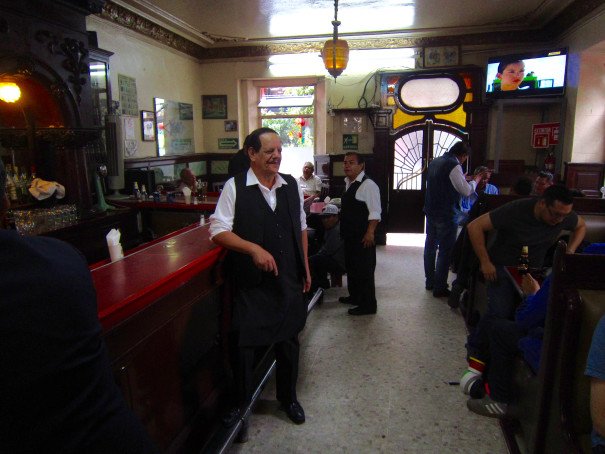
The Ghosts of Drinkers Past

The Ghosts of Drinkers Past
Tío Pepe in Mexico City
For every level of society inside and outside Mexico, cantinas serve as both toxin and tonic for drink, song, jocularity, wit, mayhem and mishap. Tio Pepe, now thought to be the oldest such bar in the old Aztec capital, has provided both in equal measure since way before it received its present name in 1878.
The cantina is nowadays a refuge for Mexican politicians, as the nation’s state department and the city’s supreme court sit in front of it. On a Tuesday at noon, we found a huddle of operatives gathered in a booth arguing amid cocktails.
We sat down with Don Sebastian Alvarez, who took up bartending at Tío Pepe in 1987, a witness to the ebb and flow of politicians, luminaries and troublemakers passing through the doors.
Alvarez, who admitted it was against the rules to name names, told us that one time, “A certain representative walked into the bar (roughly at noon). He asks for a drink.”
The bartender says, “As you know, by law we cannot serve to those already drunk.”
The lawmaker says, “I made that law, and I can unmake it. So give me a drink.”
Don Sebastian says he kindly escorted the elected official out of the bar. This is Mexican politics. Maybe they did, maybe they didn’t.
As such, it is difficult not to place the cantina in a romantic light – but why shouldn’t we? To its advantage, the den is small, a half dozen booths and a couple of tables. But its people, veteran pourers, give it life.
Alvarez doesn’t drink, but suggests their Negroni – one part gin, one part Campari, digestive and orange peel (85 pesos, or roughly $4.50). “It’s good for a strong hangover,” says el Don.
Swinging saloon-style doors on the cantina’s north and west faces are inlaid with stained glass, in line with the frosted panels that bind the outer walls. Inside, the bar itself is backed by an elaborate, imported façade with wooden arabesques and mirrored panels. The moniker “Hennessy” arches above the centerpiece in colored glass, a temple’s gate.
Cantinas hold sway in Mexico as placeholders for the particular political, social and geographic context within which they were created, having provided little corners of free will that cut across the land for the men that ruled – and those drinking holes that only decades ago yielded to a more modern view with all allowed, women, children and vendors in tow. (Women were first allowed in 1982.)
The litany of literary figures that have gone through the place may well be exaggerated, but they nevertheless add to a visceral sense that ghosts still haunt the bar. And how fitting that Tío Pepe sits at the corner of streets Dolores and Independencia (literally “pains” and “independence”).
“I was in a cheap cantina off Dolores Street, Mexico City,” said William S. Burroughs in Junky. “The place was suffused with a dim yellow light. A moldy looking bullhead mounted on a plaque hung over the mahogany bar. Pictures of bullfighters, some autographed, decorated the walls. The word ‘saloon’ was etched in the frosted-glass swinging door. I found myself reading the word ‘saloon’ over and over. I had the feeling of coming into the middle of a conversation.”
The bull’s head and toreador pics are gone, but the swinging doors and “saloon” statements remain. And we feel that conversation.
Address: Independencia 26
Telephone: +52 55 5521 9136
Hours: Mon.-Thurs. noon-10pm; Fri. noon-11pm; Sat. noon-9:30pm; closed Sunday
This article comes from the Culinary Backstreets“Behind Bars” series—which celebrates classic drinking establishments from across the globe and, more importantly, the dedicated bartenders who pour drinks there.
